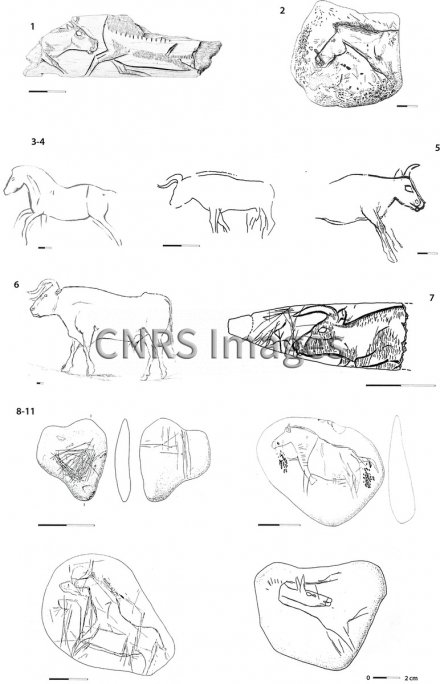Production year
2016

© Nicolas NAUDINOT/ Camille BOURDIER / CEPAM / TRACES / PLOS ONE / CNRS Images
20170070_0007
Animal figures engraved on bone or stone, discovered in various deposits dating from the Late Magdalenian (figures 1 to 7) and the Early Azilian (figures 8 to 11). Begun in 2013, the digs at the Rocher de l’Impératrice site in Plougastel-Daoulas, Finistère, led to the discovery of engraved schist tablets dating from the early Azilian. These tablets, the oldest evidence of artwork in Brittany, show a geometric register (hatching, grids and zigzags) as well as naturalistic representations of horses and aurochs. Artistic remains from this period (figures 8 to 11) are particularly rare, and this discovery provides a link between the naturalistic figurative art of the preceding Magdalenian culture (figures 1 to 7) and the development of geometric art painted and engraved on small stones during the Azilian. (Naudinot N, Bourdier C, Laforge M, Paris C, Bellot-Gurlet L, Beyries S, et al. (2017) Divergence in the evolution of Paleolithic symbolic and technological systems: The shining bull and engraved tablets of Rocher de l'Impératrice. PLoS ONE 12(3): e0173037.)
The use of media visible on the CNRS Images Platform can be granted on request. Any reproduction or representation is forbidden without prior authorization from CNRS Images (except for resources under Creative Commons license).
No modification of an image may be made without the prior consent of CNRS Images.
No use of an image for advertising purposes or distribution to a third party may be made without the prior agreement of CNRS Images.
For more information, please consult our general conditions
2016
Our work is guided by the way scientists question the world around them and we translate their research into images to help people to understand the world better and to awaken their curiosity and wonderment.